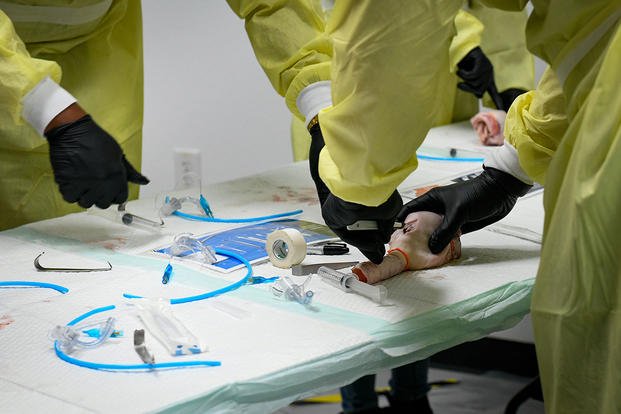

A nonprofit animal rights and medical ethics organization is suing the Defense Department for refusing to disclose details on its use of pigs and goats for medical training at four major military hospitals.
The Physicians Committee for Responsible Medicine, a group of roughly 17,000 doctors who promote plant-based diets and aim to protect animals from research and testing, filed a federal lawsuit Oct. 23 seeking documents on medical training at Naval Medical Center Portsmouth, Virginia; Madigan Army Medical Center, Washington; Darnall Army Medical Center, Texas; and Naval Medical Center San Diego.
The suit alleges that at least 80 invasive procedures, including stabbing and evisceration, have been conducted recently on the animals and the DoD has refused to release documents on the training despite a Freedom of Information Act request.
Read Next: Prosecutors Seek a 17-Year Prison Term for Pentagon Secrets Leaker Jack Teixeira
According to the group, the DoD has ignored the FOIA and has not responded to subsequent emails and phone calls on the inquiry.
“The violation of federal law — of not producing this information in a timely manner, ignoring requests or just continually delaying it — this lack of full transparency is concerning,” said retired Navy Cmdr. Erin Griffith, an emergency medicine physician and longtime PCRM member, in an interview with Military.com.
The DoD has had a policy in place since 2011 that limits the services’ use of live animals for medical training if alternatives like advanced simulators, mannequins, cadavers or actors can provide the same level of proficiency.
Using dogs, cats, nonhuman primates and marine mammals for such military medical training is generally prohibited under the directive.
In 2014, the Pentagon clarified the policy with an intention to “fully transition to the use of simulations” for most training, but it did not apply to combat or survival skills.
“Medical simulation technology will be used to the maximum extent practicable, before the use of live tissue training to train medical professionals and combat medics of the DoD,” a 2019 update to the directive states. “The use of live tissue training within DoD may be used as determined necessary by the medical chain of command.”
The Defense Department and the Navy declined to comment, citing the ongoing litigation. The Army did not respond by publication.
Griffith said the PCRM suspects that the Pentagon violates its own policies, despite evidence showing that animal use is not as effective as state-of-the-art simulators.
Documentation obtained by PCRM noted that Naval Hospital Portsmouth uses 60 pigs a year in emergency medical training.
“Doing these trauma procedures requires you to know anatomy to do the procedures correctly. I don’t have to tell you the differences of the anatomy of a pig and a human — it’s everything from how much pressure you need, how thick the skin is, to the shape,” Griffith said. “It’s definitely not human anatomy.”
A 2022 Government Accountability Office report found that, while the DoD has taken steps to replace animals in trauma training, it has failed to show how well it is doing with this goal because it lacks measurable objectives for making assessments.
“DoD does not have performance measures upon which to rely when assessing DoD’s programs in reducing its use of animals,” GAO analysts wrote.
The GAO recommended that the DoD develop performance measures and clarify guidance to reduce and replace the use of animals in trauma training.
“By developing specific and measurable objectives and performance measures for monitoring progress, DoD could provide greater assurance that it could assess progress in increasing its use of alternatives to live animals during trauma training,” they wrote.
In military journal articles and other publications, members of the U.S. defense community have said training with live animals is invaluable — not just the medical treatment portion but the mental training needed to handle the emotional shock of violence.
“[Such] training also provides clinical and psychological ‘conditioning for the horrors and chaos of war,'” a 2013 article in the Journal of Military and Veterans’ Health states.
But Griffith, who has deployed to combat and trained on goats and pigs as a military emergency physician, said realistic, high-tech simulators cause equal levels of distress and the DoD “overestimates” the role a sedated animal plays in lieu of performing trauma treatment on a battle buddy.
“You can’t in the moment be emotional about the tragedy of what has occurred. You have to tap into your training and the science and your education in order to best treat the patient,” Griffith said. “I can tell you, having treated people in combat, that you rely on repetitive procedural training, which you can do over and over on a [human] simulator.”
The group cites studies by the U.S. and Canadian militaries that show simulation training is as effective or even more so than practicing on animals. According to the group, 97% of emergency medicine residency programs — 284 of the 292 programs — surveyed in the U.S. and Canada train without animals, including emergency medicine programs affiliated with the Air Force at Wright State University and the Army at the Medical College of Georgia.
Related: With Medical Readiness at Stake, Pentagon Embarks on Plan to Fix the Military Health System
